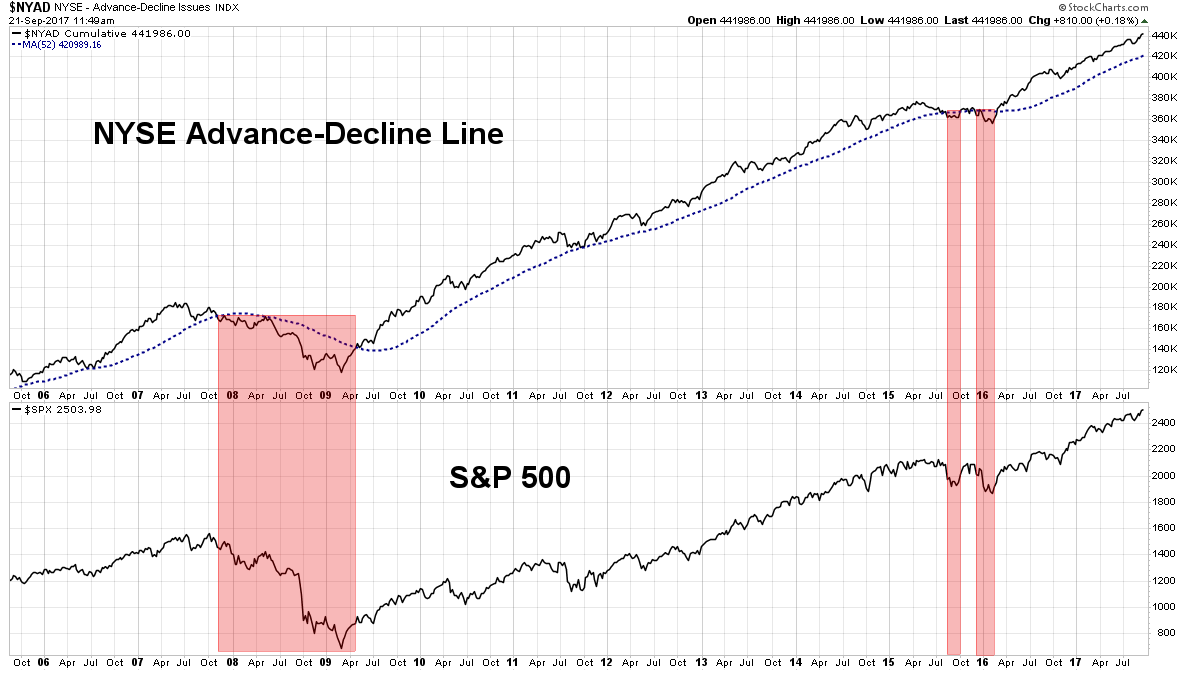While we normally see markets face pressure around this time of the year, it appears we may have dodged a bullet. This time on Financial Sense, we spoke with technical analyst Louise Yamada of LY Advisors about her take on equities, the tech sector, and what she looks for to determine market direction.
Markets Healthy
From the long-term perspective, markets appear to be healthy, Yamada stated. The advance-decline lines are confirming the new highs, she noted.
Some indicators have been showing negative divergence over the year, such as new highs versus new lows. While these have come back into positive territory recently, they haven’t exceeded the readings of the past year, leaving the negative divergences in place to possibly be overcome if things improve, Yamada noted.
This suggests we may see a pullback at a later date, and we haven’t seen a fall of 2 percent in some time, she added, but she expects something like that to occur in the shorter term, with long-term prospects appearing to be strong.
Tech Still a Standout
The technology sector continues to outperform. Interestingly, the current run-up in tech stocks does resemble conditions similar to those seen in 2000, Yamada noted.
If tech stocks can prove earnings, that would indicate a difference from what we saw in 2000. They are extended, however, and a sideways consolidation for some would be welcome.
“Technology isn’t just outperforming,” she said. “It’s the only sector that’s been outperforming until recently. … We have for many years felt that technology may well be the new industrial sector because that’s the direction that so much is moving in and directing the economy.”
There have been signs healthcare is starting to perk up again, she added. It may be joining tech in outperformance and suggesting that there will be a broadening out.
Part of this move in tech so far may have more to do with playing catch-up, however. When we consider the decline in 2000, we had a 78 percent drop in the Nasdaq, implying the need for a longer repair time, Yamada stated.
“We didn’t see a breakout,” she said. “We saw a repair process that went until about 2012, when it finally broke above the prior peak. That was the point at which we suggested it had entered a new structural bull market.”
Just this past year, we saw a breakout through the 2000 high, which is impressive, Yamada noted. This could indicate the beginning of another advance in tech stocks that could equal the 2009 advance.
Utilities are also performing well, in line with Yamada’s thesis that tech may be the new industrial sector.
“The utilities may well be the back-up or the energy for the high-tech environment,” she said. “There may be fundamental reasons behind this. … They’re really the basic material of the new high-tech environment. It’s very impressive that we’re seeing them move from defensive to perhaps offensive.”
Treasury Yields Headed Higher
Though rates aren’t up as much as some had anticipated, Yamada expects we’ll see the trend continue.
Historically, the reversal from rising to falling rates has been sharp, she noted. However, the reversal from falling to rising rates is traditionally a very slow, 2- to 14-year process, and we’re about 8 to 9 years into a basing process now, she added.
Looking at the 2-year Treasury yield, which is most sensitive to the Fed’s rising rates, it’s broken out through the 2009 to 2010 level, and is now seeing some consolidation, which appears healthy.
If and when the 10-year moves through 3 percent, we will have actual evidence of a higher high and a higher low for interest rates, Yamada noted, which will define the ultimate reversal.
“We think it’s still in progress,” she said. “We don’t see it falling significantly lower unless something really untoward happens in the world. … It would probably be healthy to raise rates another time and bring some normalization to the underlying economic improvement that we’ve been seeing.”
What to Look for Going Forward
Right now, Yamada sees positive signals for equities. From the market perspective, the advance-decline line suggests the long-term outlook is OK, and that can start to deteriorate 4 to 9 months before a market setback, she noted.
On a shorter-term basis, over the past year, we still have those divergences in some indicators, though she’d expect to see more sectors begin to break down if a top were forming.
If it turns out some equities are entering bear markets, she suggests vigilance.
“I think the investor has to look at his portfolio and keep mental stop-losses, and raising the stop loss as a stock goes higher,” she said. “If your stock begins to break a support that’s been in place for a period of time, I think you’d take a little off the table. You don’t go into the stock market to underperform.”
Listen to this full interview with Louise Yamada CMT by clicking here.







